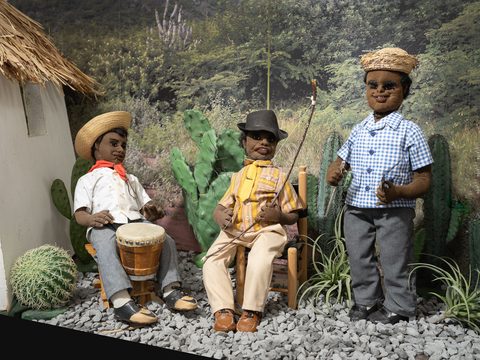
The Maasdamme Collection: Scenes from the colonial past
The exhibition The Maasdamme Collection is on view from October 16. This collection of dioramas by Rita Maasdamme (1944–2016) tells about the histories of the former Dutch colonies from the unique perspective of enslaved people, Maroons, and the Indigenous population.
Meet more than 130 “creations,” as Maasdamme herself called the dolls in the dioramas. When Maasdamme started making dioramas in the 1980s, she was showing a history that she and many others of her generation, both in the Netherlands and the former colonies, had never learned at school; from the slave market at the harbor of Paramaribo, a Maroon village, and Tula’s revolt to more contemporary scenes, such as a depiction of Campo Alegre, an open-air brothel in Curaçao.
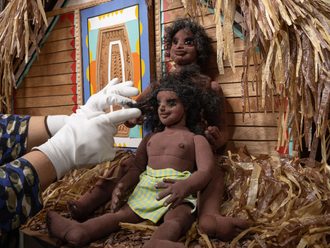
Diorama from the exhibition The Maasdamme Collection, 2022, photographer: Amsterdam Museum.
Especially detailed creations
The creations are purely handcrafted and made entirely from fabric. Maasdamme extensively studied the history, surroundings, and persons she depicted, recreating everything down to the smallest detail using various materials. She gave them lifelike features such as fingernails, sometimes with polish, lips that are differently hued on the inside, and teeth. She also spent attention on hair, eyebrows, and eyelashes, bringing the dolls to life even more.
Rita Maasdamme was ahead of her time. Her scenes and creatures are lovingly crafted, down to the last detail. She helps us better understand the colonial past, which is needed in this day and age.”

Gunay Uslu
Staatssecretaris Cultuur en Media
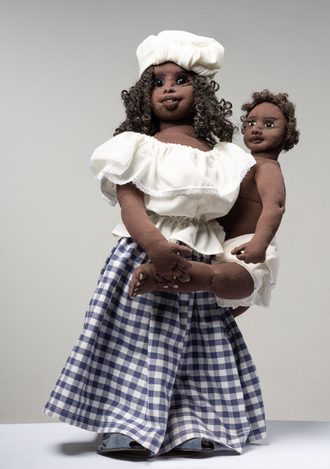
Creation by Rita Maasdamme, 2022, photographer: Amsterdam Museum.
Social justice and equality
Inez van der Scheer, Junior Curator at the Amsterdam Museum:
“As an artist and educator, Rita Maasdamme was ahead of her time and made her dioramas in a period when this topic was still very much underexposed. Driven by a strong sense of social justice and equality, she made her life’s work with love; unsung histories in fabric and thread. To do this, she conducted extensive research that enabled her to translate everything from historical prints to poems and urban legends into her narrative dioramas.
The collection—around 200 dolls in total—was her way of sharing knowledge and stimulating understanding. She was frequently on hand at every showing of her work to talk with people. We hope that this exhibition, which opens during Black Achievement Month and more than six years after Ms. Maasdamme’s passing, will do justice to her research, her passion, and her interdisciplinary and polyvocal approach to her work.”
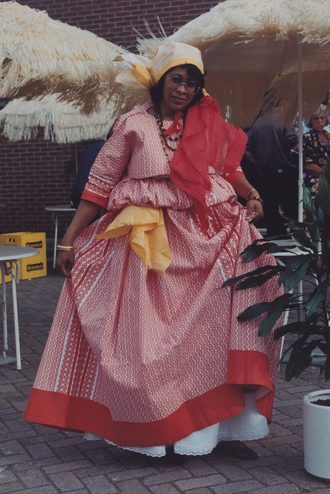
Rita Maasdamme, photographer: unknown.
About Rita Maasdamme
Maasdamme was born in Aruba in 1944 to Surinamese parents who had emigrated to the island, and started making cloth dolls with matching costumes as a nine-year-old girl. Maasdamme relocated to Amsterdam in 1963 for a practical course in fashion. She then worked as a teacher of handicrafts at different schools in Amsterdam. In the 1980s she took up making dolls again and began creating dioramas—scenes from the colonial past. She exhibited these at community centers, schools, and museums in the Netherlands and Aruba.

Bianca Maasdamme, 2022, photographer: Amsterdam Museum.
Polyvocal exhibition
Annemarie de Wildt, Senior Curator at the Amsterdam Museum:
“In the process of making this exposition we researched Rita Maasdamme’s personal archive. She drew inspiration from books and historical images, her travels and conversations with people. In the annotations that accompany the dioramas we reveal her sources and provide additional explanation.
Maasdamme is sadly no longer present to guide us through the scenes she created in the years when the legacy of slavery received far less attention than it does today. To this end, we sought out additional voices and visions. In the audio tour and videos, researchers and poets, anthropologists and family members complement the stories in the dioramas with personal and contemporary perspectives.
Among these individuals are Britha Reiziger, Bianca Maasdamme, Stacey Esajas, Vernon Chatlein, Jörgen Gario, Thomas Polimé, Victor Bottenbley, Bart Krieger, Ola Hassanain, Emmanuel Adu-Ampong, Luc Alofs, Marco van Baalen, and Kathleen Ferrier.”
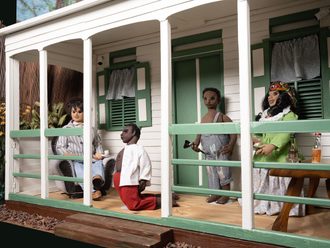
Diorama from the exhibition The Maasdamme Collection, 2022, photographer: Amsterdam Museum.
A future for the Maasdamme Collection
Rowan Stol, Junior Curator of Research at the Amsterdam Museum:
“Many of the dioramas and dolls by Rita Maasdamme have been exhibited before, at community centers, schools, and museums. With her passing in 2016, she left behind dozens of dioramas, more than 200 creations, and a large collection of clothing. In recent years, commissioned by Imagine IC, Dieuwertje Wijsmuller undertook a participatory investigation into the value of the collection and made a report on the findings.
The exhibition at the Amsterdam Museum is a continuation of this research. After the show, Maasdamme’s family would like to consign the collection to museums in the Netherlands, Suriname, or the former Netherlands Antilles. Where will the life’s work of Rita Maasdamme be best appreciated? And what can we learn from her portrayal of the colonial past and the legacy of slavery? The Amsterdam Museum invites visitors to the exhibition to share their own ideas on this topic, and will be communicating with institutions about the future of the Maasdamme collection.”